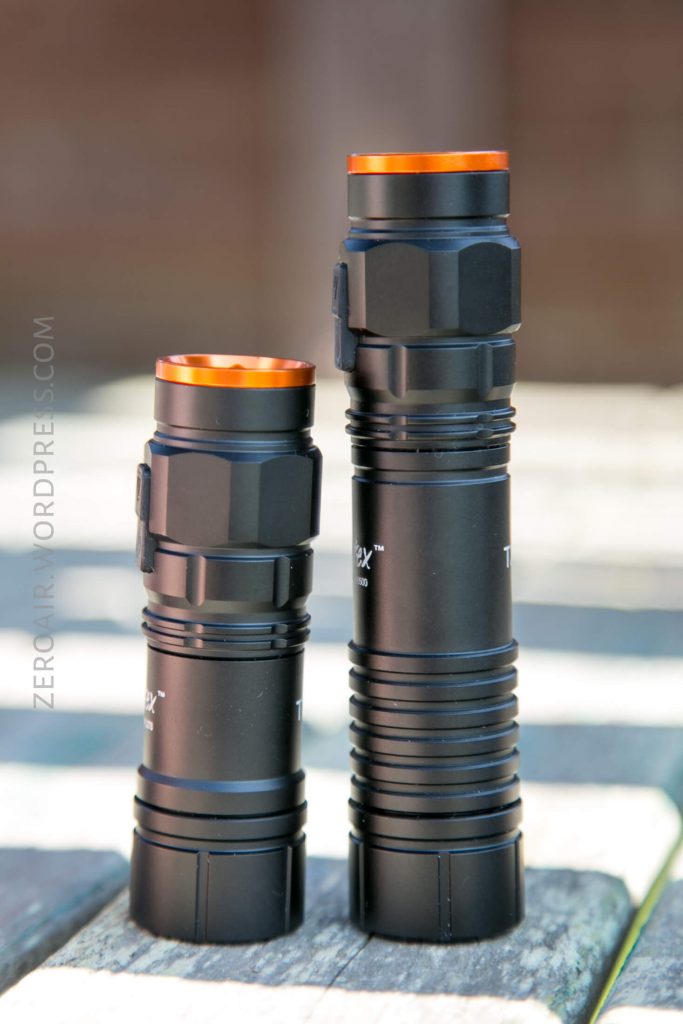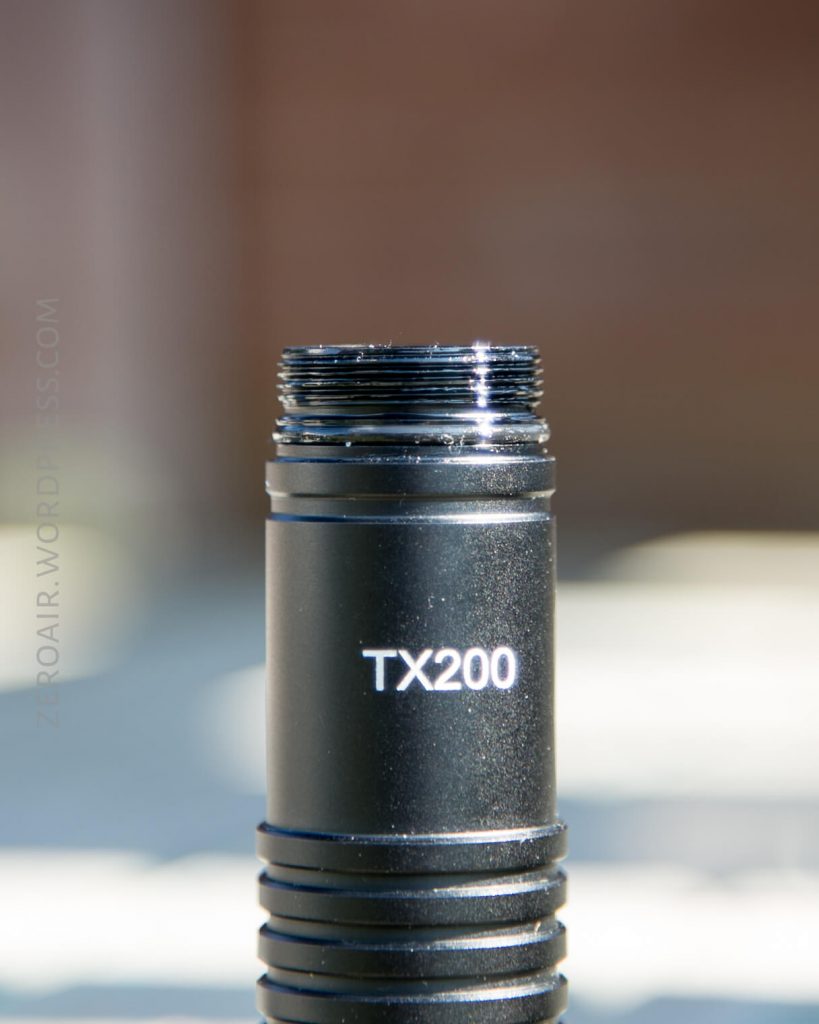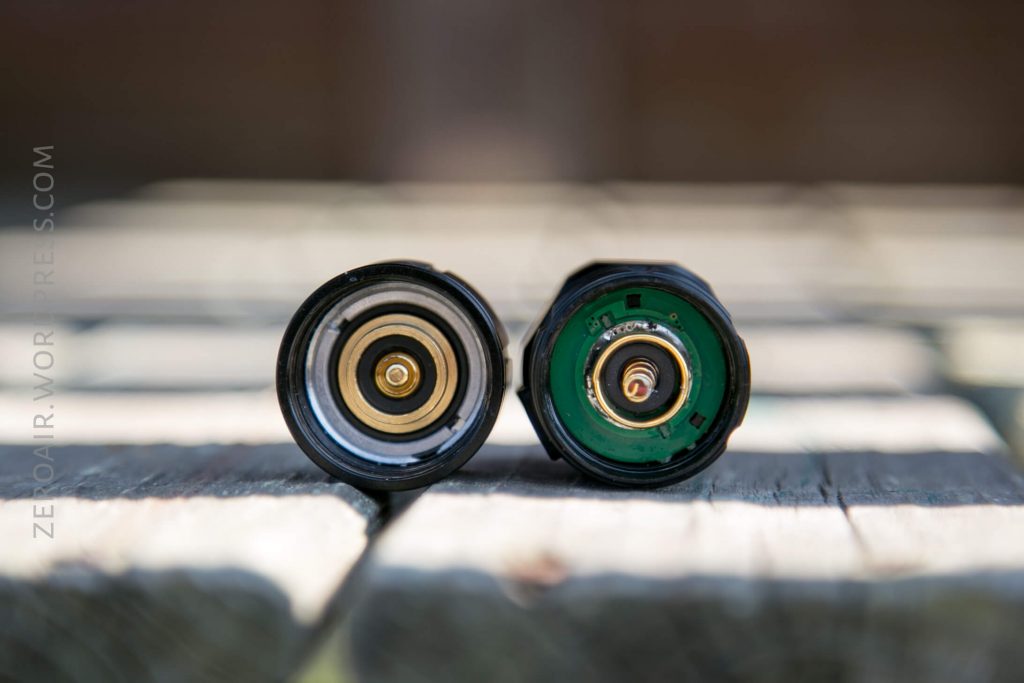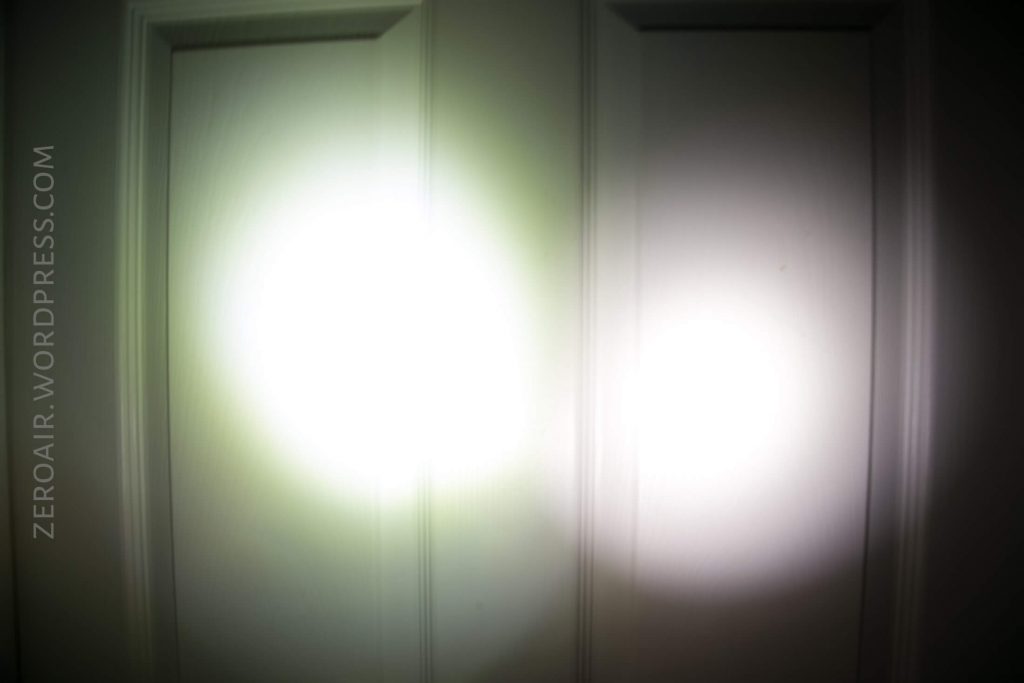Vortex TX100 and TX200 Flashlight Review
The Vortex TX100 and TX200 are clever little flashlights, offering 18650 or 18350 cell support, and a triple Cree XP-G3. Read on for testing!
Official Specs and Features
Versions
Aside from the obvious two versions mentioned above, there are no complications. Just the “18350” version, and the “18650” version.
Price
TX100: US$79.90
TX200: US$85.90
Though, to be honest, I’m not sure where these may be purchased at the moment!
Short Review
I was initially skeptical of these lights (cold call lights are not usually my favorite). Aside from a few fairly glaring issues, these lights are actually ok for their intended purpose.
Long Review
The Big Table
| Vortex TX100 | |
|---|---|
| Emitter: | Cree XP-G3 |
| Price in USD at publication time: | $79.90 |
| Cell: | 1x”18350″ |
| Turbo Runtime | High Runtime |
| LVP? | Yes |
| Switch Type: | E-Switch |
| Quiescent Current (A): | ? |
| On-Board Charging? | Yes |
| Chargetime | |
| Power off Charge Port with no Cell? | – |
| Claimed Lumens (lm) | 520 |
| Measured Lumens (at 30s) | 475 (91.3% of claim)^ |
| Claimed Throw (m) | – |
| Candela (Calculated) in cd (at 30s) | 229lux @ 3.208m = 2357cd |
| Throw (Calculated) (m) | 97.1^ |
| All my Vortex reviews! | |
| Vortex TX200 | |
|---|---|
| Emitter: | Cree XP-G3 |
| Price in USD at publication time: | $85.90 |
| Cell: | 1x”18650″ |
| Turbo Runtime | High Runtime |
| LVP? | Yes |
| Switch Type: | E-Switch |
| Quiescent Current (A): | ? |
| On-Board Charging? | Yes |
| Chargetime | |
| Power off Charge Port with no Cell? | – |
| Claimed Lumens (lm) | 1300 |
| Measured Lumens (at 30s) | 1135 (87.3% of claim)^ |
| Claimed Throw (m) | – |
| Candela (Calculated) in cd (at 30s) | 230lux @ 5m = 5750cd |
| Throw (Calculated) (m) | 151.7^ |
| All my Vortex reviews! | |
^ Measurement disclaimer: Testing flashlights is my hobby. I use hobbyist-level equipment for testing, including some I made myself. Try not to get buried in the details of manufacturer specifications versus measurements recorded here; A certain amount of difference (say, 10 or 15%) is perfectly reasonable.
What’s Included

These are two separate packages, but the contents are identical aside from the light.
- Flashlight (TX100 or TX200)
- Charge base (with screws for mounting in wall)
- Charge cable
- Orange diffuser
- Proprietary cell (“18350” for TX100, “18650” for TX200)
- Manual
Package and Manual
The lights ship in a large, cardboard box, with a window for viewing the light. The package and contents are the same – the only difference is the light contained in it, and light-specific printing on the box. The lights are held in a custom-fit plastic tray.
Build Quality and Disassembly
These Vortex lights have a pleasantly high-quality finish and are overall very well built. I won’t say directly that that surprised me, but I will say (again) that lights which I haven’t heard of, who contact me out of the blue, usually don’t provide this good of an impression.

As you can see above and below, the two versions of this light are exactly the same, differing only in cell tube size.

The anodizing is very smooth and feels thick enough to not break down with minimal use.
And as I’m sure you’ve noticed by now, Vortex has chosen the best accent color: orange. The bezel is orange.
The cells are also orange!
Have a look at the parts of the head and tail. Have a good close look.

You’ll probably notice some strangeness. That’s because these cells are proprietary. The cells may go into the light in either orientation (I’ll show you later why). So both the head and tail are built to accept this. Is that a good use of space? (Since this makes the light much thicker than it needs to be?) See the “Power” section.
The threads are triangle cut, and anodized. Quite a bit of lube on there, too. The threads play no role in electrical contact. To wit: the light will work with the tailcap completely removed! That’s a product of the cell having both positive and negative terminals on both ends. As a result, even with the tailcap completely removed, I can’t say that the light is physically locked out (!!!).
Size
Officially:
TX100: 92.6mm, and 83g.
TX200: 127.6mm, and 103g.
Both are 29.04mm in diameter.
As you can see, these lights are quite thick. T H I C C even. The TX200 is also quite a b it longer than the Convoy S2+, but at least it does add charging. The diameter is played well, though, since much more of the optic is revealed than on a Convoy S2+ triple.
Retention
There’s nothing included for carrying this light. That’s reasonably passable, though, because this isn’t really an EDC light. It’s meant to live in the power charging base. As such, I can’t really ding Vortex in this regard.
There is a wall mount charge base, though. Vortex provides screws and drywall anchors for mounting. The mount has a quick release, too. It’s a good charge base, but you’ll need to be sure it’s within reach of an outlet, so you can connect the micro-USB for power. A wall wart isn’t provided, so you’ll need to supply your own.

Power
Vortex provides cells for each light. The lights are branded as “18350” and “18650” lights, but the reality is that they aren’t. The cells are proprietary, with positive and negative terminals on both ends. Regular cells will not work in the light, and of course, may not be charged in the light. The cells may not be charged in a regular charger, either.
The light has charging terminals on the tailcap. The base has a springy terminal to match with the center positive contact.

The layout of the cell does make them reversible, but I think that’s not important since the cells are clearly designed to never be removed from the light at all. It is possible to purchase replacement cells.
Below you can see the cell terminal. It’s the same on both ends.
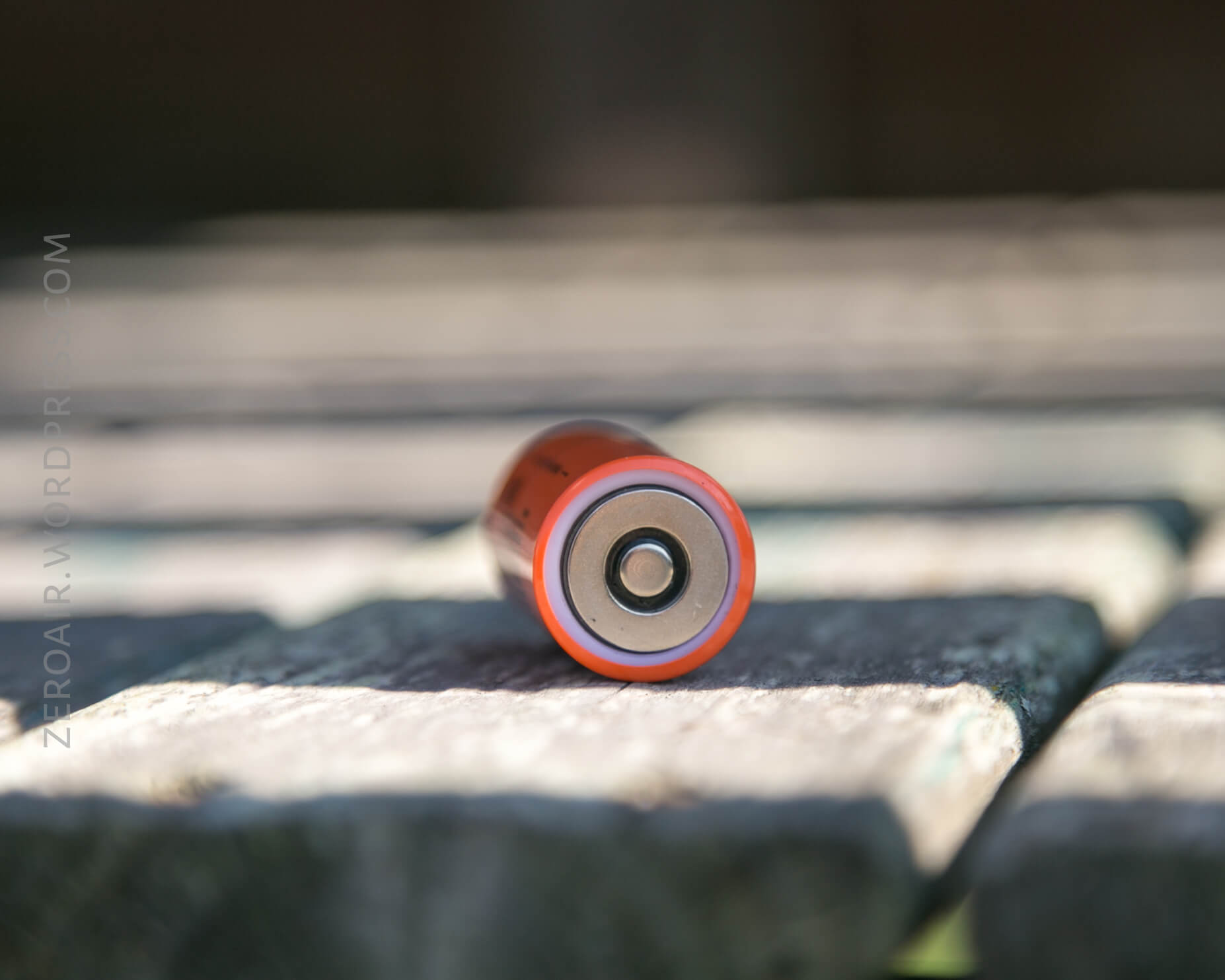
Below, the “18650” Vortex cell. It’s massive, compared to a regular HG2 18650. The actual dimensions of the “18650” are 20.7mm x 73.4mm. The “18350” is the same diameter, but 40.4mm long.


Now to answer the one huge question I had about these lights. When I said “yes” to the review, my impression (not what I was told directly, just my impression about what I was told) was, that the lights themselves come on when power is cut to the charging base. This wouldn’t be the first light to offer this, but they are certainly rare. Many people look for this feature, too.
But. That is not this light. Big frowny face: 🙁 What actually happens with this light is that if the power goes out to the micro-USB charging port, and the light is in the charging base, some emitters in the charging base are turned on per your previously selected options.
Below, the green lit LED means the light is charged.

If the power to the base goes out, and you have “on” selected (there’s a little switch), then the 3 white LEDs on the front will turn on.
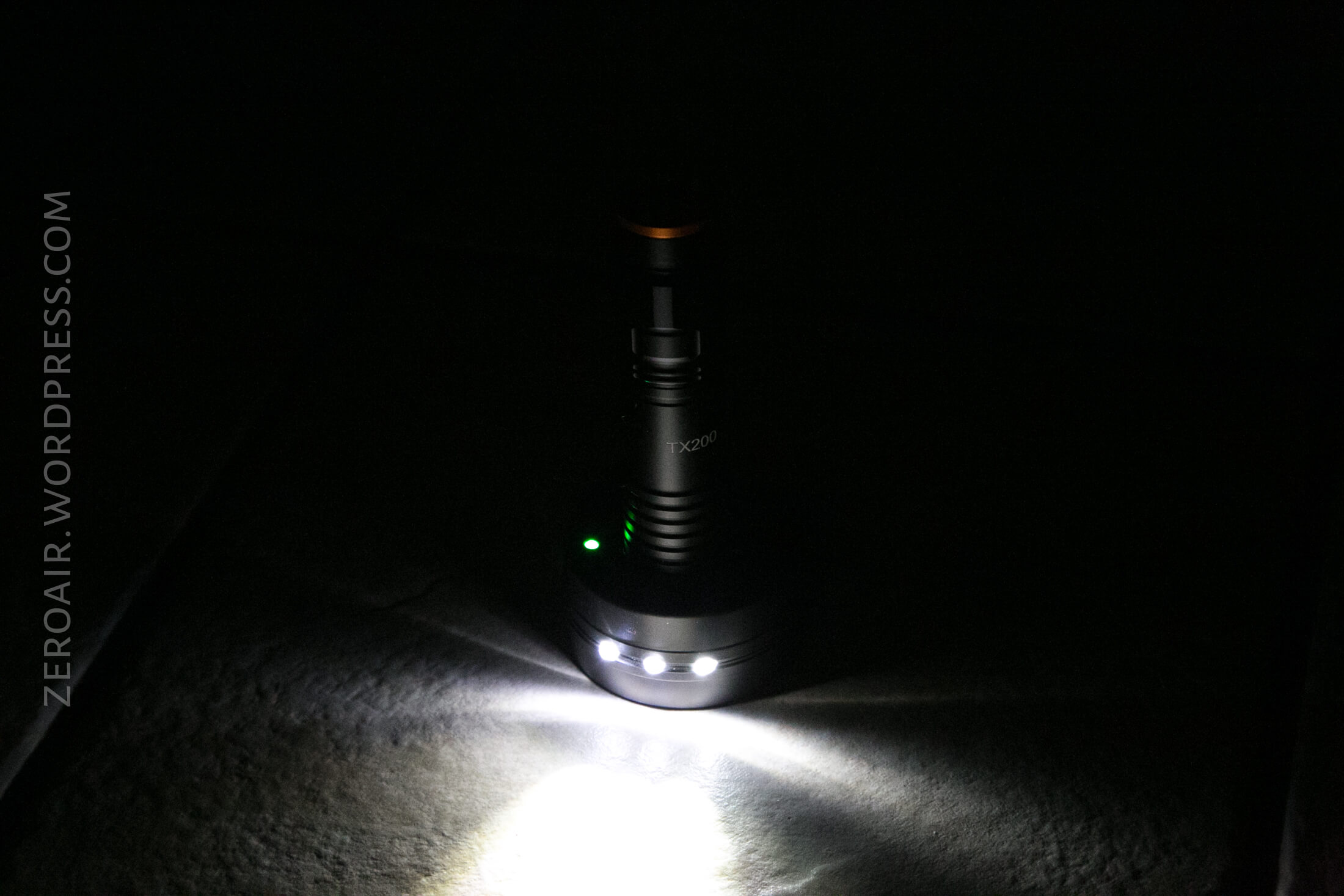
Or, solid red will turn on. And not shown, the third option of flashing red. (Slow flash, not strobe. More of a beacon.)

And the light still works when in the charge base.
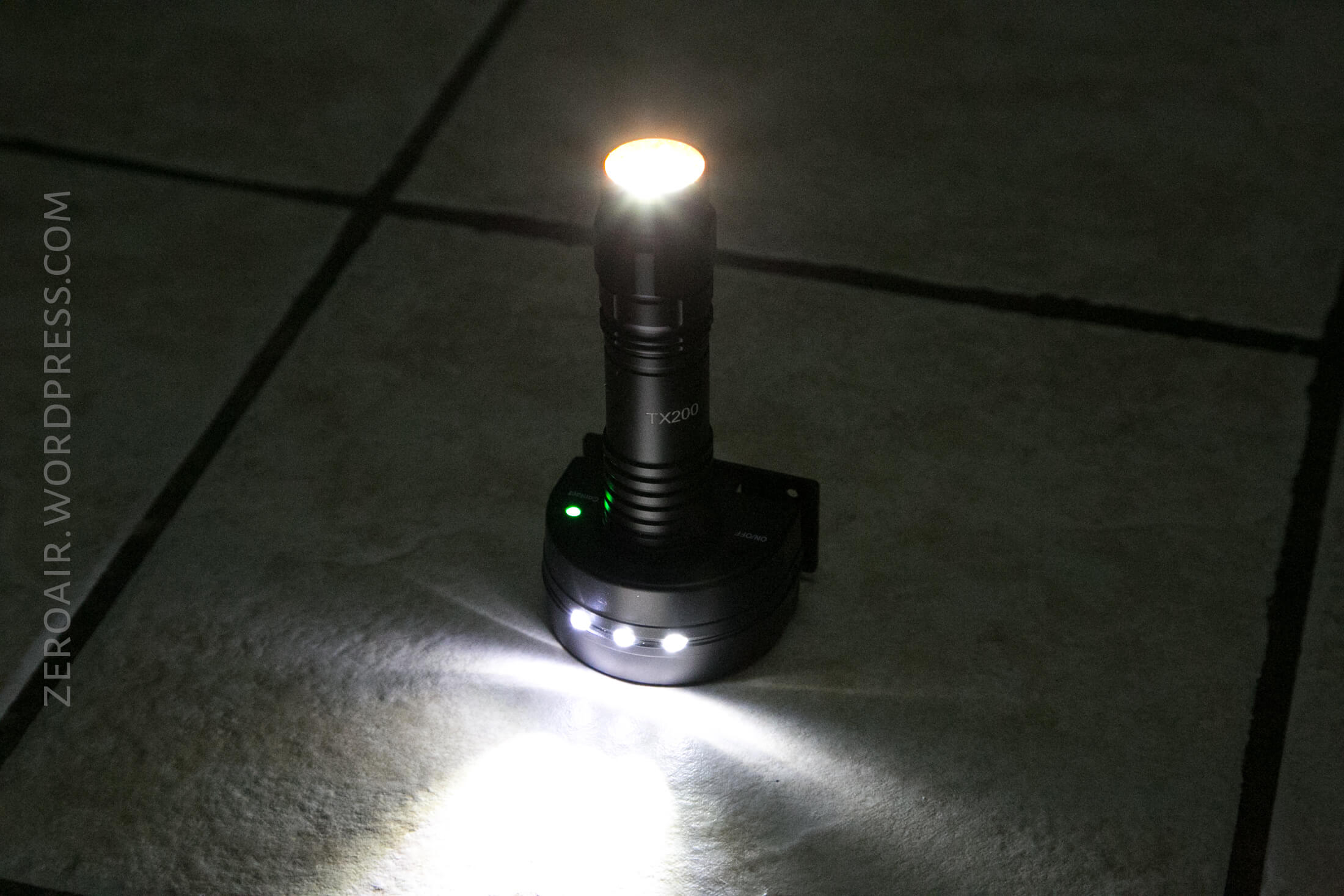
Now, is this a cool feature? Sure, it’s not bad. It could be useful, yes. But it’s not the same as “the light comes on when the power goes out” type setup.
I don’t think Vortex is being misleading in their marketing. I just misunderstood what they are offering and had my hopes up in the wrong way.
Below are some runtimes.
The TX100 High. Output is fairly stable for the first couple of minutes, then steps down to somewhere over Medium mode. The light shuts off with LVP, after giving fair warning with the indicating switch (flashing red). Note that it’s possible to reset the light to turbo, and achieve essentially the same output as initial.

The TX100 Medium run. Very boringly flat after an initial stepdown. Also shuts off with LVP, over 3V.

The TX200 on High. Very similar to the TX100, but with much higher output. It’s possible to reset to Turbo here too, but the output suffers. LVP over 3.0V is present here, too.

TX200 Medium:

Here’s some detail on the charging base. There’s a quick release, so that the wall mount may be left on the wall, and the charge base moved around. Reasonable since you absolutely must have it for charging the cell/light.
The ON/OFF switch is for telling the base what for the front emitters of the base to do when the power is out. Those emitters may be turned off completely. Cycling through the options: Off/White (On)/Red (On)/Red (Flash).



As for powering the base: one side has a micro-USB input. Vortex provides a cable, but not a wall wart. And you really need a wall wart – I don’t expect you’ll power this from USB on your computer, and have the thing mounted to your wall? That just doesn’t make sense as a reasonable setup. There’s also a tripod mounting point on the base. This could be good for travel, coupled with the orange diffuser.
You’ll note that there’s a USB “output” on one side, too. The OUT works for passthrough, as well as utilizing the cell power as a powerbank. The highest output current supported is around 0.5A.
Charging from the base proceeds reasonably. Both lights charge at around .85A, and the cells measure around 650mAh (“18350”) and ~2.5Ah (“18650”). Not bad, not the best.


User Interface and Operation
Each light has two switches. They’re side, indicating, e-switches, with rubber covers. They’re easy to find on the head, and

Here’s a user interface table! It’s the same for both lights. The heads are exactly the same! Actually, the tailcap is exactly the same too.
| State | Action | Result |
|---|---|---|
| Off | Click Power Switch (PS) | On (mode memory) |
| Off | Hold either switch | Momentary Strobe |
| Off | Click Mode Switch (MS) | No action |
| On | Click PS | Off |
| On | Click MS | Mode advance (HML direction) |
| On | Hold MS | Momentary Turbo |
| On | Hold PS | Ramp up or down (infinite modes) |
| On | Double click either | Strobe |
| Strobe | Double click MS | SOS |
The indicating switch operates for a few (5) seconds after the light is on. Blue means power is ok. Solid red means cell is ~30%. Red blinking means the cell is lower than 30%.
Don’t let that gem of infinitely variable output to slip by you. I don’t see it mentioned in the branding or the manual. It’s a very nice feature! And important for many users.
Modes
| TX100 Mode | Mode Claimed Output (lm) | Claimed Runtime | Measured Lumens |
|---|---|---|---|
| High | 520 (100%) | 40m | 475 |
| Medium | “30%” | ? | 150 |
| Low | “10%” | 315m | 47 |
| TX200 Mode | Mode Claimed Output (lm) | Claimed Runtime | Measured Lumens |
|---|---|---|---|
| High | 1300 (100%) | 100m | 1136 |
| Medium | “30%” | ? | 118 |
| Low | “10%” | 580m | ~ |
LED and Beam
The emitters are Cree XP-G3. That’s too bad, really, and one of my main complaints with the light. Hard to fault a company for picking them, though, because they are some of Cree’s latest emitters, so they should be the best, right?
Also not sure if you noticed on the head teardown, but the MCPCB in this light is Wuben branded! (In fact, the heads on these lights are eerily similar! See the To10R review. That light has XP-G3, too.)
The emitters are behind a clear optic, and the white MCPCB can be seen clearly. XP-G3’s aren’t known for their great tint, and this is no exception. There’s a lot of green, and compared to other tints I do like, this one isn’t great. Of course, the orange bezel is something I really like.


Beamshots
These beamshots always have the following settings: f8, ISO100, 0.3s shutter, and manual 5000K exposure. These photos are taken at floor level, and the beam hits the ceiling around 9 feet away.
TX100 Beamshots
TX200 Beamshots:
Tint vs BLF-348 (KillzoneFlashlights.com 219b version) (affiliate link)
I keep the test flashlight on the left and the BLF-348 reference flashlight on the right.
Conclusion
What I like
- Orange accents
- Full package lights
- They’re well built, even if I don’t like some of the design choices.
- Powerbank functionality
What I don’t like
- Proprietary cells
- They’re very large in diameter
Notes
- This light was provided by Vortex for review. I was not paid to write this review.
- This content originally appeared at zeroair.org. Please visit there for the best experience!
- For flashlight-related patches, stickers, and gear, head over to PhotonPhreaks.com!
- Use my amazon.com referral link if you’re willing to help support making more reviews like this one!
- Please support me on Patreon! I deeply appreciate your support!






